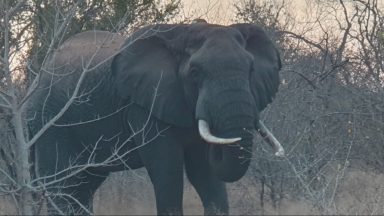Over the past two decades, Peace Parks Foundation has been assisting in restoring conservation areas and reviving biodiversity in southern Mozambique. In 2015, Peace Parks signed a 20-year agreement with Mozambique’s National Association for Conservation Areas to restore, develop, and manage Zinave National Park. Established in 1973, Zinave was later ravaged by sixteen years of civil war; however, thanks to ongoing, pioneering rewilding operations, the park’s first herds of rhino in more than four decades have been safely settling into their new habitat. Rhinos have returned to Zinave thanks to incredible translocations by Peace Parks and partners, from Manketti Game Reserve in South Africa to Zinave—the longest cross-border road transfers of black and white rhino ever undertaken.
This latest translocation in September, the third following last year’s pioneering cross-border rhino translocations, included five black rhinos (classified as Critically Endangered by the IUCN Red List of Species) and five white rhinos (classified as Near Threatened by the IUCN Red List of Species).
In this Peace Parks TV episode, we take you behind the scenes on the first phase of the ambitious rhino translocation: capturing the rhino.
The capture process begins with meticulous planning through a series of workshops and comprehensive safety briefings. Our team, composed of experts from various fields, assembles with specialised equipment and tranquilisers, purposefully designed to keep the rhino as calm as possible during the capture.
Up in the sky, a helicopter plays a crucial role in locating the rhino, which have already been placed into a large holding area months prior to this capture operation to prepare them for the journey and help them acclimate. From that vantage point, a tranquiliser dart is expertly fired, delivering a dose that gently sedates the rhino.
Down on the ground, the team of experts – field veterinarians and translocation specialists – stands ready. They approach the sedated rhino cautiously, with the utmost concern for the safety of both the animal and the team. To ensure that the rhino remains calm, they gently place a blindfold over its eyes and provide earplugs in order to encourage calmness and avoid any sensory distractions.
With the rhino in a sedated state, the team moves in to tag and mark them, to ensure that they are categorised and tracked for their safety and wellbeing. As soon as they are done securing the rhino with specialised straps and equipment, ensuring stability, they walk these mighty animals into the crates.
The crates are strategically positioned as close to the rhino as possible, ensuring a swift and efficient loading process onto the transport trucks, and the crates are then tagged once the animals have been loaded. This enables authorities to classify and monitor them, guaranteeing their ongoing security.
Join us in supporting rhino conservation through partnerships and share in the hope that, together, we can ensure that these incredible creatures not only survive but thrive, for generations to come. Stay tuned to Peace Parks TV for our next installment on this bold rewilding initiative and head over to our YouTube channel to see previous translocation videos!
This rhino translocation is the result of a collaborative partnership between Mozambique’s National Administration for Conservation Areas (ANAC), Peace Parks Foundation, and Exxaro Resources, with the support of the Government of South Africa. Exxaro generously donated the rhinos and has made a substantial contribution to the park’s operational costs, with additional funding provided by Anglo American, the De Beers Group, the Geos Foundation, the German Postcode Lottery, the MAVA Foundation, and private donors.

